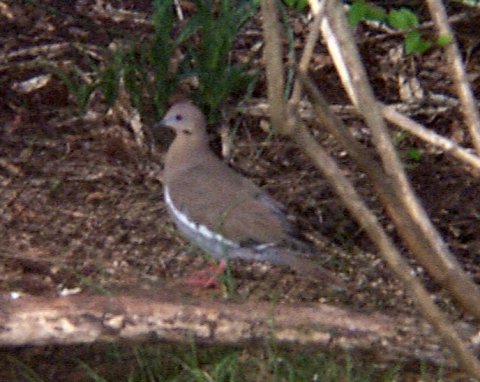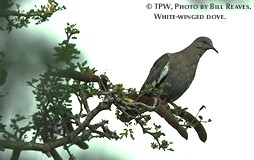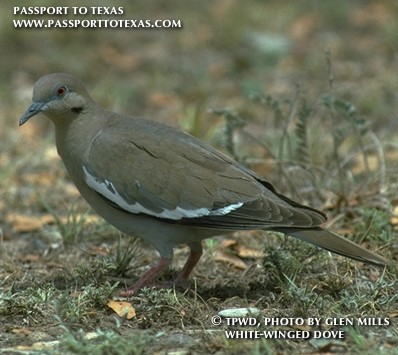|
 |
Scientific Name:Zenaida
asiatica |
| Geographical Range:Native
to Texas but has been found in Southern California, Arizona, and Southern
Florida, as well. |
| Habitat: Leafy
trees, mesquite trees, citrus trees, and desert scrub. |
| Diet in the Wild:Seeds
and fruit from cactus. |
| Conservation Status:Not
protected; this is a gaming species. |
| Location in the Zoo:
Aviary in theTexas Wild area |
|
|
Physical
Description:
Both males and females are approximately ten inches in length at maturity.
They are grayish-brown in color with a long black bill, light blue tear-shaped
ring around their eyes, a rounded tail with white markings on the feathers,
and have distinctive white patches on their wings. The adults have
been known to have black spots on their feathers, as well. |
Social
Organization:
Have been known to nest as a pair or within a colony. These birds
migrate to Central America for the winter season. |
Special
Adaptations:
Within four days of birth the bird can eat seeds along with the milk
provided by its parents. This bird can also eat the fruit from cacti.
Since this creature can also build a nest practically anywhere it is able
to construct a home in many different locations, whether it be in a tree
at a park, a shrub in the desert, or in a neighborhood with a mostly warm
climate. |
 |
|
Reproductive
Behavior:
Both the male and female work together to incubate the two eggs that
are usually laid. The eggs will hatch within about two weeks and
are fed pigeon's milk for the first four days. Pigeon's milk is milk direct
from the parent, but is exclusive to a small number of birds, including
doves and pigeons. Please note, however, that the milk is not from
a pigeon. |
The Animal
at the Zoo:
Since this animal has such a predominant presence in the state of Texas
the White-winged Dove can be found in the Texas Wild section of the Fort
Worth Zoo. |
 |
Page
Author:
Kelly L. Smith kelkel382003@yahoo.com
Sources and Links:
Florida's breeding bird atlas; Geanangel, Charles L., www.wildflorida.org/bba/wwdo.htm
USGS Identification Tips; www.mbr-pwrc.usgs.gov/id/gram1st/i3190id.html
Arizona-Sonora Desert Museum (1996-2003), www.desertmuseum.org/pollination/doves.html
Passport to Texas (August 1999), www.passporttotexas.com/birds/aug.html |
|
|